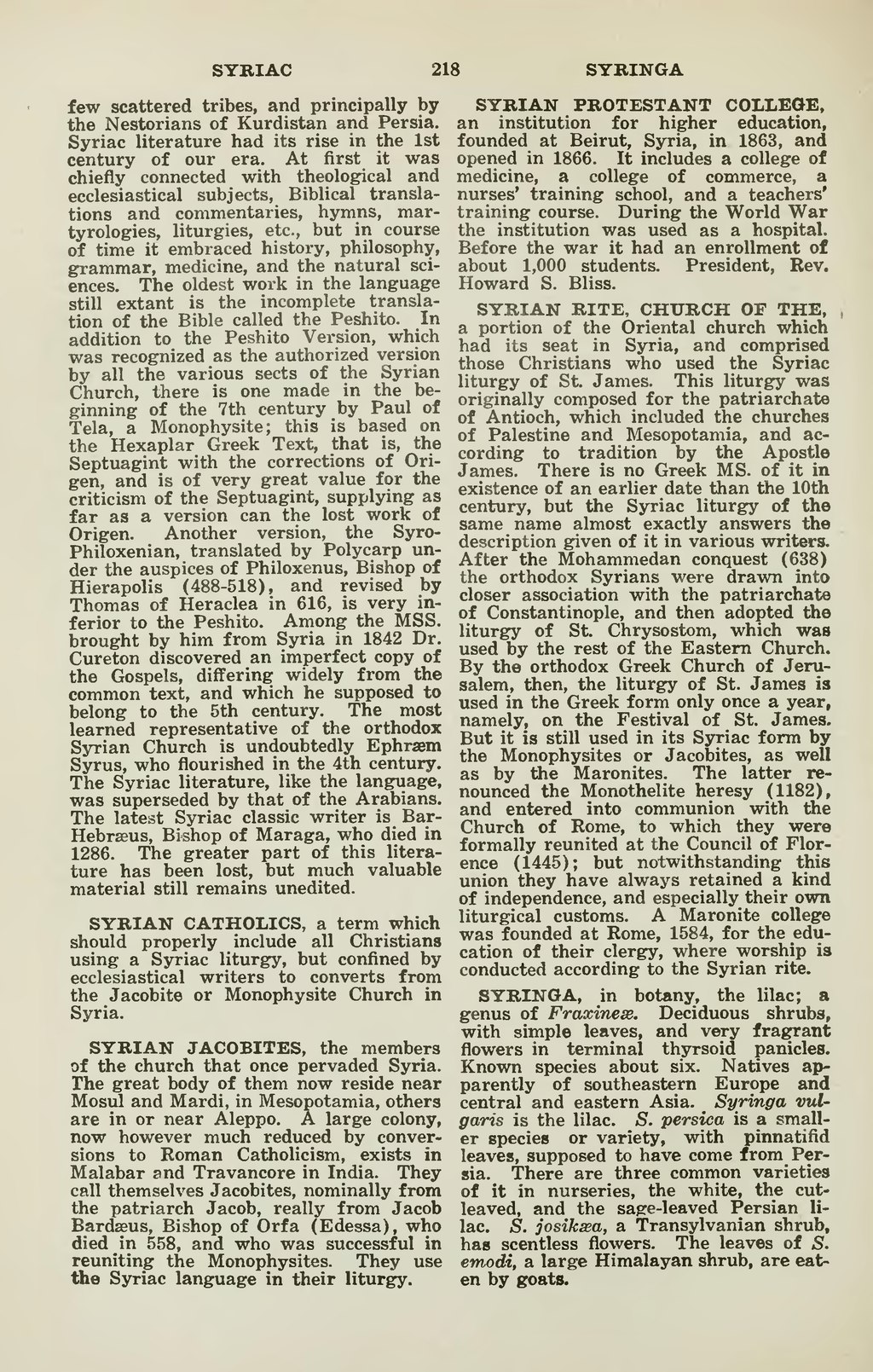SYRIAC 218 SYRINGA few scattered tribes, and principally by the Nestorians of Kurdistan and Persia. Syriac literature had its rise in the 1st century of our era. At first it was chiefly connected with theological and ecclesiastical subjects, Biblical transla- tions and commentaries, hymns, mar- tyrologies, liturgies, etc., but in course of time it embraced history, philosophy, grammar, medicine, and the natural sci- ences. The oldest work in the language still extant is the incomplete transla- tion of the Bible called the Peshito. In addition to the Peshito Version, which was recognized as the authorized version by all the various sects of the Syrian Church, there is one made in the be- ginning of the 7th century by Paul of Tela, a Monophysite; this is based on the Hexaplar Greek Text, that is, the Septuagint with the corrections of Ori- gen, and is of very great value for the criticism of the Septuagint, supplying as far as a version can the lost work of Origen. Another version, the Syro- Philoxenian, translated by Polycarp un- der the auspices of Philoxenus, Bishop of Hierapolis (488-518), and revised by Thomas of Heraclea in 616, is very in- ferior to the Peshito. Among the MSS. brought by him from Syria in 1842 Dr. Cureton discovered an imperfect copy of the Gospels, differing widely from the common text, and which he supposed to belong to the 5th century. The most learned representative of the orthodox Syrian Church is undoubtedly Ephraem Syrus, who flourished in the 4th century. The Syriac literature, like the language, was superseded by that of the Arabians. The latest Syriac classic writer is Bar- Hebrasus, Bishop of Maraga, who died in 1286. The greater part of this litera- ture has been lost, but much valuable material still remains unedited. SYRIAN CATHOLICS, a term which should properly include all Christians using a Syriac liturgy, but confined by ecclesiastical writers to converts from the Jacobite or Monophysite Church in Syria. SYRIAN JACOBITES, the members of the church that once pervaded Syria. The great body of them now reside near Mosul and Mardi, in Mesopotamia, others are in or near Aleppo. A large colony, now however much reduced by conver- sions to Roman Catholicism, exists in Malabar and Travancore in India. They call themselves Jacobites, nominally from the patriarch Jacob, really from Jacob Bardseus, Bishop of Orfa (Edessa), who died in 558, and who was successful in reuniting the Monophysites. They use the Syriac language in their liturgry. SYRIAN PROTESTANT COLLEGE, an institution for higher education, founded at Beirut, Syria, in 1863, and opened in 1866. It includes a college of medicine, a college of commerce, a nurses' training school, and a teachers' training course. During the World War the institution was used as a hospital. Before the war it had an enrollment of about 1,000 students. President, Rev. Howard S. Bliss. SYRIAN RITE, CHURCH OF THE, a portion of the Oriental church which had its seat in Syria, and comprised those Christians who used the Syriac liturgy of St. James. This liturgy was originally composed for the patriarchate of Antioch, which included the churches of Palestine and Mesopotamia, and ac- cording to tradition by the Apostle James. There is no Greek MS. of it in existence of an earlier date than the 10th century, but the Syriac liturgy of the same name almost exactly answers the description given of it in various writers. After the Mohammedan conquest (638) the orthodox Syrians were drawn into closer association with the patriarchate of Constantinople, and then adopted the liturgy of St. Chrysostom, which was used by the rest of the Eastern Church. By the orthodox Greek Church of Jeru- salem, then, the liturgy of St. James is used in the Greek form only once a year, namely, on the Festival of St. James. But it is still used in its Syriac form by the Monophysites or Jacobites, as well as by the Maronites. The latter re- nounced the Monothelite heresy (1182), and entered into communion with the Church of Rome, to which they were formally reunited at the Council of Flor- ence (1445); but notwithstanding this union they have always retained a kind of independence, and especially their own liturgical customs. A Maronite college was founded at Rome, 1584, for the edu- cation of their clergy, where worship is conducted according to the Syrian rite. SYRINGA, in botany, the lilac; a genus of Fraxiness. Deciduous shrubs, with simple leaves, and very fragrant flowers in terminal thyrsoid panicles. Known species about six. Natives ap- parently of southeastern Europe and central and eastern Asia. Syringa vul- garis is the lilac. S. persica is a small- er species or variety, with pinnatifid leaves, supposed to have come from Per- sia. There are three common varieties of it in nurseries, the white, the cut- leaved, and the sage-leaved Persian li- lac. S. josiksea, a Transylvanian shrub, has scentless flowers. The leaves of S. emodi, a large Himalayan shrub, are eat- en by goats.
Page:Collier's New Encyclopedia v. 09.djvu/262
This page needs to be proofread.
LEFT
218
RIGHT
